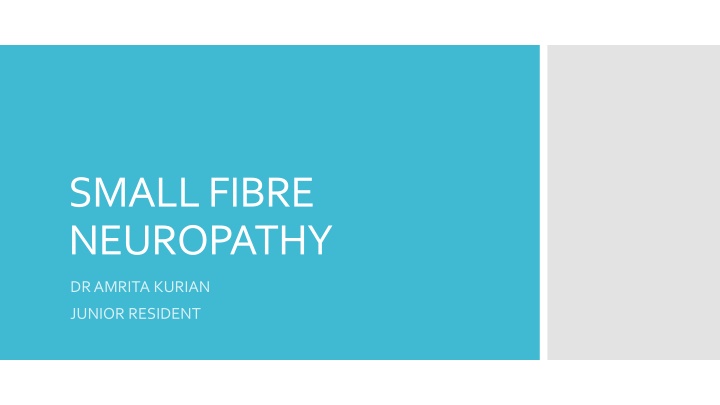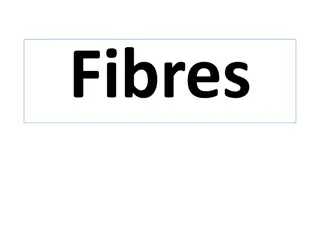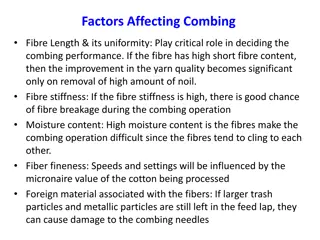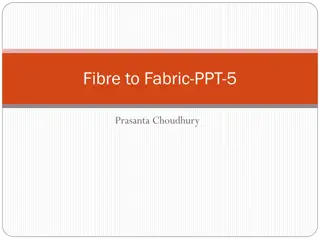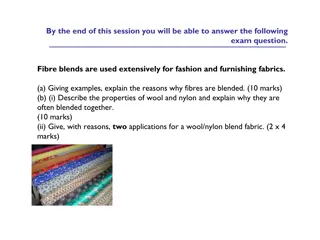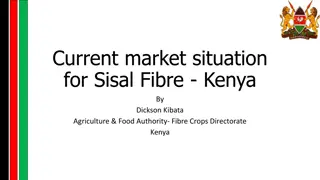SMALL FIBRE
Small fiber neuropathy involves thin and unmyelinated nerve fibers, leading to various sensory disturbances. The Erlanger and Gasser classification details the different types of nerve fibers involved. Symptoms include burning, tingling, and numbness, often presenting in a stocking-glove pattern. Diagnosis is based on clinical features and nerve conduction studies, with treatment aimed at symptom management. Understanding the classification and symptoms can aid in early detection and effective management of small fiber neuropathy.
Download Presentation

Please find below an Image/Link to download the presentation.
The content on the website is provided AS IS for your information and personal use only. It may not be sold, licensed, or shared on other websites without obtaining consent from the author.If you encounter any issues during the download, it is possible that the publisher has removed the file from their server.
You are allowed to download the files provided on this website for personal or commercial use, subject to the condition that they are used lawfully. All files are the property of their respective owners.
The content on the website is provided AS IS for your information and personal use only. It may not be sold, licensed, or shared on other websites without obtaining consent from the author.
E N D
Presentation Transcript
SMALL FIBRE NEUROPATHY DR AMRITA KURIAN JUNIOR RESIDENT
Erlanger and Gasser classification of nerve fibres
LARGE FIBRE Heavily myelinated A alpha : somatic motor , proprioception A beta : proprioception, touch, vibration A gamma : motor to muscle spindle 12 -20 m diameter 70 120 m/s (saltatory conduction)
SMALL FIBRE Thinly myelinated and unmyelinated A delta : 1-6 m, 4- 36 m/s Fast pain (sharp, lancinating) Cold
C fibre : 0.2 -1.5 m, 0.4 - 2.8 m/s Slow pain (burning, dull, poorly localized ) Warmth Post ganglionic sympathetic Most numerous
Loss of pain and temperature perception Autonomic dysfunction WHEN TO SUSPECT? Preserved vibratory and position sense Preserved muscle strength Preserved DTR Normal NCS
Small fiber neuropathies can occur without large fiber involvement, but in some cases they occur concomitantly or progress to involve large nerve fibers.
Mostly occur in a symmetric length-dependent fashion : stocking- glove pattern Sensory changes starting in the feet and gradually ascending up the legs and then to the hands. SYMPTOMS Commonly reported neuropathic symptoms : Combinations of burning, tingling, numbness, sunburn-like and frostbite-like sensations
Symptoms can vary widely in severity. Gradual onset of distal symptoms in the form of vague disturbances of sensation in the feet. The feeling of a wrinkle in a sock that cannot be removed or of small pebbles or sand in the shoe. A cold-like pain, tingling or a pins and needles sensation. More severe symptoms include burning pain that often is persistent, although it may vary in intensity throughout the day.
Many also report transient electric shocklike pain, usually lasting only seconds, but quite severe and potentially multiple times per day. Many symptoms worsen during periods of rest and at night. In addition to spontaneous pain, many individuals report allodynia and hyperesthesia. Patients frequently complain that the bedsheets are exquisitely painful, and therefore, wear socks or use foot tents to keep the sheets from making physical contact with the feet.
Autonomic and enteric dysfunction. Dry eyes, dry mouth postural lightheadedness, presyncope, syncope palpitations abnormal sweating erectile dysfunction nausea, vomiting, diarrhea, constipation, early satiety difficulty with urinary frequency, nocturia, and/or voiding
Random patterns suggest an immune cause Symptoms may also have a non length dependent distribution that is asymmetric, patchy, intermittent, and migratory Can involve the face, proximal limbs, and trunk. Symptoms may vary throughout the day. Eg:startingwith electric-shock sensations on one side of the face, followed by perineal numbness and then tingling in the arms lasting for a few minutes to several hours.
May be seen with diabetes and other common etiologies, but they often suggest an underlying immune-mediated disorder such as Sj grensyndrome or sarcoidosis. Although large fiber polyneuropathy may also be non length dependent, the deficits are usually fixed, with no migratory component.
UPTO HALF OF THE CASES - IDIOPATHIC CAUSES DIABETES IS THE MOST COMMON IDENTIFIABLE CAUSE
Diabetes and prediabetes (including both impaired glucose tolerance and impaired fasting glucose) Individuals with diabetes and metabolic syndrome appear to have twice the risk of developing a small fiber neuropathy compared to those with diabetes alone. Recent reports now are suggesting that the single largest contributing factor to neuropathy development is hyperlipidemia.
Some patients with diabetes also may experience an acute painful small fiber neuropathy associated with rapid glycemic control, also referred to as insulin neuritis or treatment-induced neuropathy. HIV Hepatitis C Leprosy Inflammatoryneuropathies (such as Guillain-Barre syndrome and chronic inflammatory demyelinating polyneuropathy) Celiac disease Restless legs syndrome
complex regional pain syndrome type I paraproteinemia neurotoxic drug use systemic lupus erythematosus Sjogren s syndrome abnormal thyroid function Amyloidosis (AL) paraneoplastic syndromes Inherited conditions : Fabry s disease and the hereditary sensory and autonomic neuropathies.
DETAILED HISTORY Diabetes mellitus, hypothyroidism, chronic liver disease or kidney disease CLINICAL ASSESSMENT History suggestive of CTD and autoimmune conditions Alcohol use Family history of neuropathy
Use of neurotoxic medications such as metronidazole, colchicine, and chemotherapeutic agents. Relevant risk factors for HIV and Hepatitis C (eg, blood transfusions, sexual history, intravenous drug use) Recent illnesses and vaccinations, as a small-fibervariant of Guillain-Barr syndrome has been described
EXAMINATION Normal or near normal physical and neurologic examination. The coordination, motor, and reflex examinations will be normal. Light touch, vibration, and proprioception also may be normal, resulting in diagnostic confusion in some situations. Patients may have decreased pinprick, decreased thermal sensation, or hyperalgesia in the affected region.
Mildly decreased vibratory sensation in some individuals. However, absent ankle jerk and reduced vibratory sense may also occur in healthy elderly people. Associated skin changes in affected areas may include dry, cracked, or shiny skin, with discoloration and loss of hair. Brittle nails Orthostatic hypotension
The history and physical examination findings still are considered the gold standard against which all tests are compared when making a diagnosis of a small fiber neuropathy. A detailed review of the symptoms, rate of progression, and complaints suggestive of autonomic fiber involvement DIAGNOSIS Generally, if a patient presents with a compelling history for a small fiber neuropathy and an appropriate clinical exam, further testing to confirm the diagnosis may be unnecessary.
Quantitative sensory testing (QST) Measures the detection threshold of accurately calibrated sensory stimuli. Heat or heat-pain detection thresholds are considered the most useful and specific for evaluation of a small fiber neuropathy. Psychophysical in nature; requiring cooperation from the patient. In conditions of cognitive impairment (due to disease or medication), the reliability of the test results are in question.
If abnormal, may signal dysfunction anywhere along the sensory pathway between the receptor apparatus, primary sensory cortex and association cortex. Thus, abnormalities in either the central or peripheral nervous system can result in the same deficit. QST is unable to distinguish between feigned and true loss of sensation.
Skin Biopsy Skin specimens are obtained by 3-mm punch biopsy of the distal leg and thigh Bright field immunohistochemistry is used with antibodies against protein gene product 9.5, a marker for all peripheral nerve fibers, and fiber densities are calculated. Reduced intraepidermal nerve fiber density on skin biopsy is seen in small fibre neuropathy Also seen in fibromyalgia and chronic pain syndromes.
Corneal confocal microscopy is a promising new noninvasive diagnostic tool that provides objective quantification of small nerve fibers in the sub basal layer of the cornea, which holds the densest concentration of these fibers
Quantitative sudomotor axon reflex testing A non invasive autonomic study that assesses the volume of sweat produced by the limbs in response to acetylcholine. A measure of postganglionic sympathetic sudomotor nerve function, QSART has a sensitivity of up to 80% QSART can also be considered in cases where skin biopsy may be contraindicated (eg, patient on anticoagulation). Affected by a number of external factors, including caffeine, tobacco, antihistamines, and tricyclic antidepressants; these should be held before testing
Other diagnostic studies Tilt-table and cardiovagal testing : for patients with orthostatic hypotension and palpitations. Thermoregulatory sweat testing can be used to evaluate patients with abnormal patterns of sweating, eg, hyperhidrosis of the face and head. EMG and NCS are normal in pure small fiber neuropathies. If there is possible larger fiber involvement causing symptoms or occurring concomitantly with a small fiber neuropathy, these studies might be helpful
Serological tests to determine the etiology
Diabetes and prediabetes Diabetes is the most common identifiable cause of small fiber neuropathy and accounts for about a third of all cases. Impaired glucose tolerance is also thought to be a risk factor and has been found in up to 50% of idiopathic cases of small fibre neuropathy.
Metabolic syndrome Hyperlipidemia, hypertension, and obesity in addition to abnormal glucose metabolism with insulin resistance. Individuals with diabetes and metabolic syndrome have twice the risk of developing a small fiber neuropathy compared to those with diabetes alone Recent reports suggest that the single largest contributing factor to neuropathy development is hyperlipidemia ( via inflammatory pathway and oxidative stress)
Vitamin B12 deficiency Correctable cause Causes : decreased intake, pernicious anemia , medications that interfere with absorption (PPI, H2 receptor blockers , metformin) Tests : CBC and peripheral smear Serum vitamin B12 level Methylmalonic acid or homocysteine level in patients with subclinical or mild vitamin B12 deficiency
Celiac antibody panel T-cell mediated enteropathy characterized by gluten intolerance and a herpetiform-like rash 2 presentations : neuropathy symptoms are preceded by the onset of gastrointestinal symptoms, or they may occur in isolation.
Inflammatory disease testing Sj grensyndrome accounts for nearly 10% of cases of small fiber neuropathy. non length dependent Can precede sicca symptoms for up to 6 years, and in some cases are the sole manifestation of the disease. SFN may also be associated with vasculitis, systemic lupus erythematosus, and other connective tissue disorders.
Testing should include: Erythrocyte sedimentation rate, CRP and antinuclear antibodies: Extractable nuclear antigen panel: SSA AND SSB autoantibodies The Schirmer test or salivary gland biopsy should be considered for seronegative patients with sicca or a suspected immune mediated etiology,
Leprosy Segmental demyelination is the final common pathway of nerve injury in leprosy Sensorynerve conduction, cold and warmth perception -most frequently and earliest affected
Commonnerve trunks involved : the ulnar and median nerves (claw hand) the common peroneal nerve (foot drop) the posterior tibial nerve (claw toes and plantar insensitivity) the facial nerve (lagophthalmos) the radial cutaneous nerve the great auricular nerve Lab tools : skin biopsy and PCR
Regardless of the cause , managing symptoms remains the key as pain and autonomic dysfunction can markedly impair the quality of life. MANAGEMENT A multidisciplinary approach incorporating analgesics, physical therapy and lifestyle modifications is ideal. Treat the underlying cause whenever identified.
Antidepressants anticonvulsants opioids topical treatments.
Tricyclic antidepressants (TCAs) consistently are recommended as first tier drugs across all guidelines Selected as first-tier choices based on their efficacy and other factors such as cost and availability. mechanism of action : inhibition of serotonin and norepinephrine reuptake.
TCAs also have anticholinergic effects that can cause significant side effects for some patients, and specifically should be avoided in elderly adults. Contraindicated in patients with a significant cardiac history, glaucoma, or recent monoamine oxidase inhibitor (MAOI) use
Anticonvulsants also are routinely recommended for the treatment of neuropathic pain. Gabapentin frequently is utilized as a first-line treatment of neuropathic pain(specifically postherpetic neuralgia and painful diabetic neuropathy). Mechanism of action : via the voltage-gated 2 calcium channel, modifying the release of excitatory neurotransmitters. Well tolerated and not known to cause significant drug drug interactions.
Pregabalin Mechanism of action : through the voltage-gated 2 calcium channels and is a presynaptic inhibitor of the release of glutamate, substance P, and calcitonin gene related peptide (CGRP) Should be used with caution in patients with congestive heart failure. Angioedema rarely has been described as a side effect. Combination regimens : combined gabapentin and nortriptyline were more effective than either drug alone for neuropathic pain.
Serotoninnorepinephrine reuptake inhibitors (SNRIs) Both duloxetine and venlafaxine are recommended as second-line agents in most guidelines. Effective in painful diabetic neuropathy Should be avoided in patients with uncontrolled narrow-angle glaucoma or those being treated with MAOIs Rare cases of abnormal bleeding, hepatotoxicity, and serotonin syndrome, ILD, eosinophilic pneumonia
Topical lidocaine frequently is recommended as a first- or second- line treatment of focal neuropathic pain. Recommendations are typically for the lidocaine patch, also for lidocaine gel Act by decreasing neuronal membrane permeability to sodium ions. Should be avoided in regions of skin breakdown
Lastly, opioids and tramadol frequently are recommended as second-or third-line medications across all guidelines. Tramadol and its active metabolite bind to central -opiate receptors and inhibit ascending pain pathways. Tramadol also causes serotonin and norepinephrine reuptake inhibition, another potential mechanism of pain relief. Not preferred for chronic treatment.
Over-the counter-supplements : acetyl-l-carnitine and alpha lipoic acid and omega-3 fatty acids from seal oil improved corneal fibre density in patients with diabetic neuropathy
